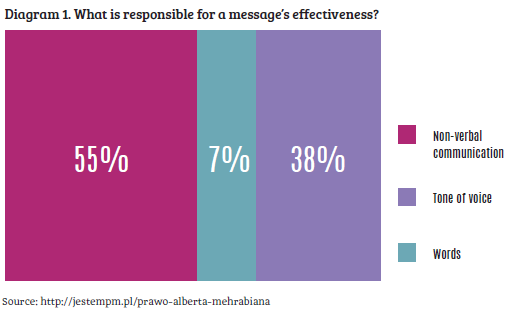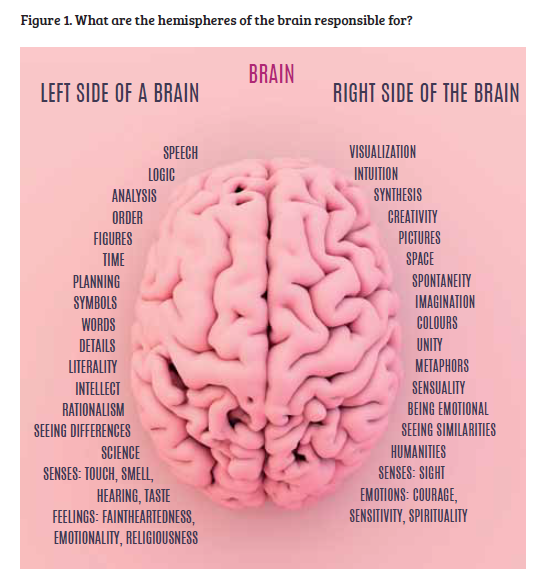Storytelling - facts and myths
Storytelling is an increasingly popular tool in sales. When practiced and refined, it can bring measurable results in the form of improved results and better customer relations. However, there are still a few storytelling myths that are circulating in the world of sales. Let’s have a look at three beliefs about storytelling and see if they’re true.

1. It doesn’t matter what you say, it just matters that you say something
MYTH
This oft-repeated myth appears in the context of both storytelling and public speaking. It all began with the research of Albert Mehrabian, now a professor emeritus of psychology at the University of California. From the beginning of his academic career, Mehrabian was fascinated with interpersonal communication. In 1967, he published a now well-known equation with significant applications in marketing. Thanks to Mehrabian, everyone who’s ever participated in an effective communication workshop knows 93% of communication is non-verbal - a combination of body language and tone of voice. The remaining 7% is wasted on words, which is why it’s often said that it doesn’t matter what you say, only how you say it. For sure?
If that were the case, people would be able to communicate on a daily basis using gestures, murmurs and body posture (similar to the way monkeys communicate). However, research shows that we receive an average of 100,000 words per day. If those words were responsible for only 7% of communication, that would be a terrible waste. Fortunately, that isn’t true, and words are not only our main form of communication, they are dangerously effective. First things first.
Let’s start with what Albert Mehrabian really proved and where we’ve gone wrong in drawing conclusions from his research. His study subjects were shown interpersonal messages consisting of the abovementioned three aspects (words, body language, and tone of voice), e.g. a man with lowered eyebrows and clenched fists who says, ‘I love you’. The subjects were supposed to assess the credibility of the messages. On this basis, Mehrabian published an immortal sentence: “the combined effect of simultaneous verbal, vocal and facial attitude communications is a weighted sum of their independent effects – with the coefficients of .07, .38 and .55, respectively”. (Mehrabian, Ferris, 1967, Inference of Attitudes from Nonverbal Communication in Two Channels. Journal of Consulting Psychology 31)1. Everything would be fine, if not for the fact that the sentence is taken out of context and is used to prove that the manner of communication is more important than the message itself. When someone refers to Mehrabian’s formula, I like to ask them to tell me the results without using words. Since words theoretically have a significance of 7%, that shouldn’t be a problem, right? Of course, it is a problem, because words are responsible for 100% of our message, not 7%. So why did Mehrabian’s study diminish the role of words, and are his conclusions reliable at all? Of course, the professor showed a very interesting relationship. It turns out that we actually believe gestures, facial expressions, and tone of the voice more than words, but only in one case: when the verbal message is not consistent with the non-verbal one (e.g. when someone who appears to be grimacing in pain assures us that they’re all right).
Conclusion: Even the loveliest words won’t bring success if we speak in a shaky, timid voice, hiding behind the projector. Only a consistent, confident message can make storytelling effective.
Finally, it is worth reading the research, which confirms that the power of words is really intriguing. In 1974, Elizabeth Loftus and John Palmer conducted a study in which, after a collision between two cars, they asked witnesses about the speed of the vehicles. However, different terms were used to ask the question: they were asked at what speed the cars had ‘bumped,’ ‘hit,’ and ‘crashed into’ each other. Depending on the term used, the witnesses reported a speed range from 51 km/h to even 65 km/h2. What’s more, those asked about a ‘crash’ (the strongest term used in the study) claimed that after the accident there were pieces of glass on the street, which wasn’t true. This is a proof that how we describe certain situations or ask certain questions has an amazing impact on the answer and on people’s memories.
This is also evident in several other situations. On the one hand, we know that flying is the safest means of transport, and on the other, when we hear about an air crash, many of us prefer to spend several hours in the car rather than fly. Does that mean that the right story is more powerful than rational facts and figures?
Wykorzystałeś swój limit bezpłatnych treści
Pozostałe 72% artykułu dostępne jest dla zalogowanych użytkowników portalu. Zaloguj się, wybierz plan abonamentowy albo kup dostęp do artykułu/dokumentu.








 Zaloguj się
Zaloguj się








